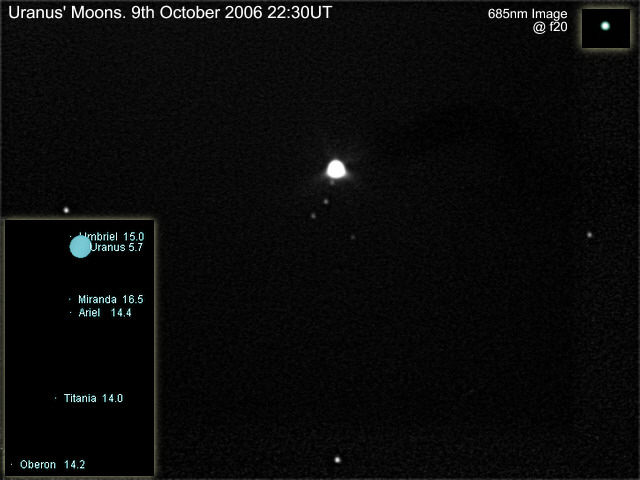


Uranus
Uranus is the 7th Planet
from the Sun, at 19AU distance (1 AU (Astronomical Unit) is the average distance
between the Earth and the Sun). It is roughly four times the radius of the earth.
However at it's great distance it appears very small and faint in an amateur
telescope. It is possible to glean a little detail from the planet using a CCD
camera, there are also a small number of brighter moons within the range of
a CCD equipped telescope.
These moons are Oberon, Umbriel, Ariel, Titania
and Miranda. The greatest challenge to imaging the moons
is the relative brightness of the planet they orbit. Below are my attempts to
image the moons of Uranus.
|
The conditions were terrible this night. There was a haze in te sky and the moons were barely visible on the screen. This is a stack of several 17 second frames. The moons are close to the planet and difficult to see. Roll your mouse over the image to see the moons labelled. An indication of how bad the visibility was, usually I would take several three to five second exposures to image the moon's of Uranus. On this night I needed 17 second exposures to get anything. |
||
|
||
| The image taken below is a combination of 45 - five second images, stacked in Registax 3. The telescope is a 222mm F8 Newtonian. The image is at Newtonian focus. The imager is a modified Vesta 685 with a replacement black & white CCD. |
||
 |
This image was taken on the night of the 9th of October 2006. The air was pretty steady and the planet very easy to find, it being near to a bright star. Three moons are visible: The far inset shows the position of the moons as displayed in Carte-Du-Ciel. Inset above is an image of the planet Uranus taken at F20 through a 685nm+ filter. |
|
|
|
4th October 2004 The autumn of 2004 was very poor for astronomy. There were only three or four clear nights throughout the season in my part of the UK. As a consequence
I didn't get much of a change to image Uranus, this was my first
attempt. Considering the altitude of the planet this was a surprisingly
good result. I used a 222mm
F8 Newtonian. The CCD was an SC3 modified Vesta webcam. |
|
|
|
30th October 2004 This was a second attempt to image Uranus on the 30th of October 2004. This time I only captured three of the moons. I also made an image of Uranus which wasn't over exposed for comparison (see inset) |
|